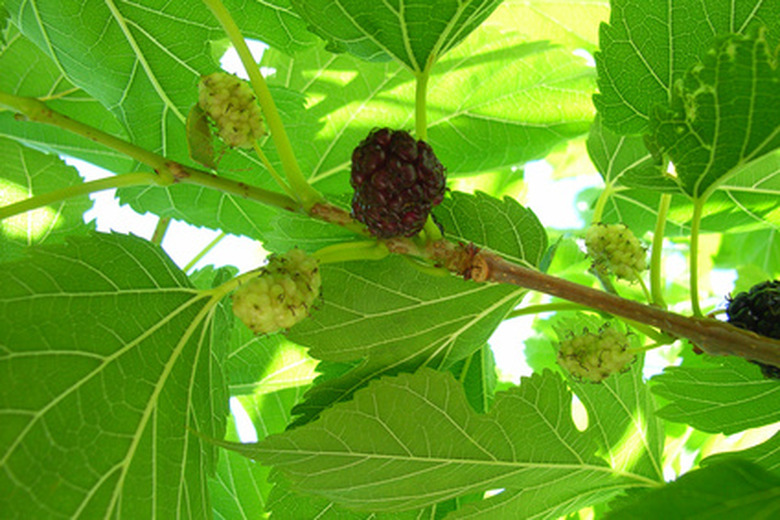Mulberry Tree & Birds
One of the quickest ways to invite birds and other wildlife to your yard requires planting a mulberry tree. Once the tree starts producing fruit, birds flock to the branches, finding the black or red berries an important food source in the summer. The trees also make great locations for bird nests. While birds find the tree highly attractive, people also eat the fruit from the mulberry tree with the shade from the tree making it even more desirable in the landscape.
History
Settlers used to rely on mulberries as an important food source. They spread sheets under trees with ripened fruit, then shook the branches to get the fruit to drop. They then used the mulberries to create jam and wine. Early farmers relied on the first opening buds of the tree as an indication that the danger of frost had passed. Farmers also planted mulberry trees to sidetrack birds so they stayed away from their more important food crops.
- One of the quickest ways to invite birds and other wildlife to your yard requires planting a mulberry tree.
- While birds find the tree highly attractive, people also eat the fruit from the mulberry tree with the shade from the tree making it even more desirable in the landscape.
Description
Mulberry trees feature light green foliage with greenish flowers that turn into long fruits ripening in midsummer. Some mulberry fruits reach up to 7 inches in length although the average size tends to be about 2 to 3 inches. The deciduous trees often reach 100 years or more in age with trunks that grow to several feet in diameter. The spreading nature of the tree provides lots of places for birds to nest and rest, especially between bouts of eating the tree's abundant fruit.
Varieties
Several varieties of mulberry trees give gardeners a choice as to what works best in their garden. One variety, the native red mulberry tree, grows naturally in the eastern United States, reaching up to 50 feet in height. The tree produces sweet red and black fruits. The white mulberry tree grows to 40 feet in height, featuring white, pink or violet fruits that mature in late summer. Although the fruit from the white mulberry seems less tasty to humans, birds find the fruits very desirable.
- Mulberry trees feature light green foliage with greenish flowers that turn into long fruits ripening in midsummer.
- The white mulberry tree grows to 40 feet in height, featuring white, pink or violet fruits that mature in late summer.
Planting and Care
Mulberry trees prefer full sun and well-drained soil, growing best in hardiness zones 7 to 10. The plants grow roots that require a deep loam rather than shallow soils such as chalk or gravel. While the trees tend to be drought-tolerant, they require water in dryer climates to make sure the fruit doesn't drop before fully ripening. Mulberry trees require little fertilization. The tree also requires minimal pruning, mainly to remove dead wood.
Stains
Some gardeners find the bluish-black stains deposited after birds eat the berries a big nuisance. One of the best ways to avoid the mess requires planting the trees away from sidewalks and concrete driveways in areas where the stains seem less noticeable.
- Mulberry trees prefer full sun and well-drained soil, growing best in hardiness zones 7 to 10.
- While the trees tend to be drought-tolerant, they require water in dryer climates to make sure the fruit doesn't drop before fully ripening.
Fruitless Trees
Even though some gardeners and landscapers want to avoid the mess mulberry fruits cause, the tree should not avoided as it offers plenty of other benefits. The male white mulberry trees work well in landscapes since they do not produce fruit. The male trees still make great nesting sites for birds, and the shade the tree offers makes it worthwhile for consideration. The tree's longevity also makes it desirable in some landscapes.
